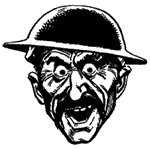Vocabulary.
Army Slang – Terms used by soldiers and historians alike.
Jingo Lingo – Paul Fussell’s list of “high diction”. One for the poets…
The following is a list of terms used during the Great War.
- 1. Soldiers/Personnel.
Anzac. The Australian troops.
B.E.F. British Expeditionary Force. The name for the British army.
Boche/Fritz/The Hun/Jerry. Slang terms for the German soldiers.
Kitchener’s Army. Recruits who responded to the famous campaign by Lord Kitchener for ten thousand men. The Battle of The Somme in 1916 is often remembered for the high percentage of Kitchener’s army that took part.
N.C.O. A non-commissioned officer.
Pals Battalions. A battalion primarily composed of men from the same area – the most famous of these being the Pals Battalions from the North Midlands (The Acrington Pals, the Sheffield Pals), who suffered massive casualties on the first day of the Battle of The Somme.
Poilu. A French soldier.
R.A.M.C. A doctor in the Royal Army Medical Corps, also named by the soldiers as “Rob All My Comrades”
Tommy/ Tommy Atkins. A British private soldier.
V.A.D. (Voluntary Aid Division). An untrained nurse sent to assist the medical staff at the front and at home. Vera Brittain was a V.A.D.
2. Guns and Ammunition.
Big Bertha. A large German Gun
Jack Johnson’s. A type of shell, named after an American boxer.
Whizz-bang. A shell, named because of the noise it made whilst falling.
3.Others
Billets. Resting place for soldiers, usually behind the lines.
Blighty. Taken from the Hindustani name for “home”, Blighty referred to Britain. It was also used to describe a debilitating wound – to “get a Blighty” was to receive a wound serious enough to be posted home.
Bully. Bully beef. The standard ration issued to the troops. It came in large cans and was by all accounts, revolting.
Casualty Clearing Station. An area just behind the lines where
casualties were sent initially. The staff in the clearing station would treat
any immediate wounds and then attempt to move the soldier to a safer location
further from the fighting. Dug-Out.
A shelter hollowed in the side of the trench system, in which soldiers could
rest or hide in if they were being shelled.
DORA. The Defense Of The Realm Act. Passed within days of the outbreak of war to help maintain law and order in Britain and to safeguard it from German spies. Forbade the sale of binoculars, imposed curfews and was the cause of pubs closing during the daytime.
Estaminet. A café, usually impromptu, that sold basic food and wine to soldiers behind the lines. Ouefs et frites (egg and chips- usually lumps of fried potato), and wine with sugar in it were the standard foods sold. (British soldiers disliked the sour taste of unsweetened wine).
Inky Pinky Parlez-Vous. Doggerel. This line doesn’t mean anything at all.
The Line. The trench system. The Front Line directly faced the enemy. The Support Line was between 200 metres-1 kilometer behind. The Reserve Line was approx 400metres –3 kilometres behind this line. Behind the Lines was any area following, usually where the troops went to rest.
Napoo. None, or no more. Comes phonetically from the French “il n’y en a plus” (there isn’t any more).
No Man’s Land The area between the trenches of both armies
NYDN. Not Yet Diagnosed Neurasthenic. The medical term casualty clearing stations attached to patients whom they considered may be suffering from shellshock.
Offensive. A large scale attack. The term was also used in official army terms to describe a state of mind in the soldiers. Hence the long-running joke in The Wipers Times “Are we offensive as we ought to be?”
Ragtime. A style of American music, ragtime also meant “incompetent” (as used in the song “Fred Karno’s Army”
Redoubt. An area of the trenches surrounded by fighting or jutting further towards the enemy than adjoining sections of the line.
Respirator. An early type of Gas Mask.
Salient. An outcrop of the trenches bringing it closer the enemy lines. For example, the Ypres Salient curved around the ruined city for approx three kilometres in a rough horseshoe shape. It could be attacked by the Germans from three sides and at times was only 50 metres from enemy lines.
Sam Browne. A belt worn by officers. It crosses the chest from left to right, and then circles the waist.
Shellshock. A blanket term used for what is now known as Post-Traumatic Stress Disorder. However, the term was applied to virtually every psychological condition relating to the war. Shellshock was originally thought to be caused by the wind of passing shells disturbing the equilibrium of the brain.
Wipers. Slang for the town of Ypres
